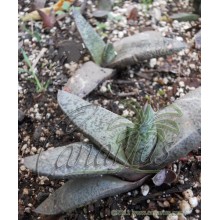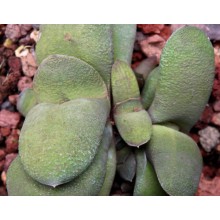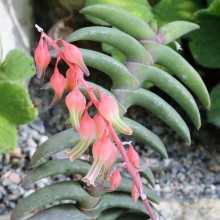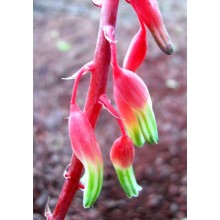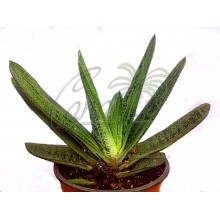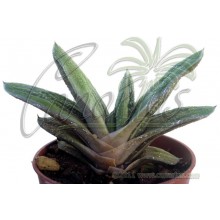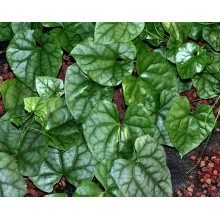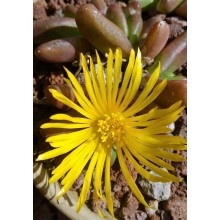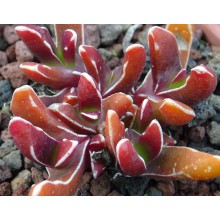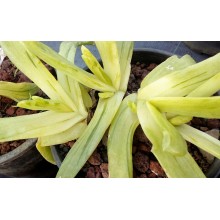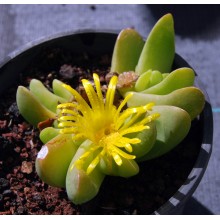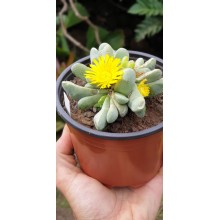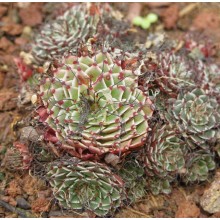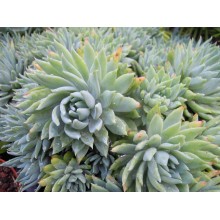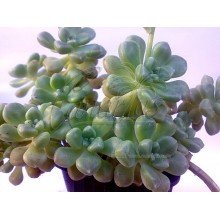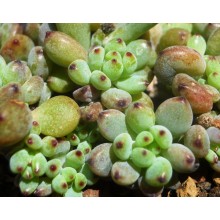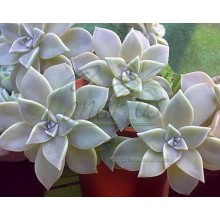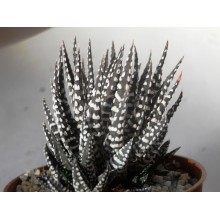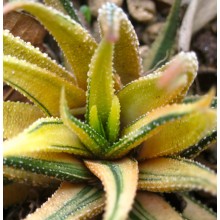Succulents There are 628 products.

World deserts and dry areas are home to the most interesting plants. Canarius offers an increasing selection of succulent plants of maximum quality, because they are grown outdoors, under the full sun of the Canary Islands.
Succulents or "fat plants" are water-retaining species, adapted to dry conditions. They store succum (juice, water) in their leaves, stems or roots, and often show a stout and fleshy appearance.
Subcategories
-
Agave
Agave is a genus of succulent plants from America. Some species grow in cold areas and take hard frost, while some others live in tropical climates. Some are tiny dwarfs and some are giants, up to 2 or 3 m wide.
Cold hardy agaves can create an exotic effect in your garden. Agave species make fine companions to palms or cacti. Variegated agaves are incredibly sought after by collectors. Our web shop offers an ever changing selection of species. We ship bare rooted plants, unless otherwise specified.
-
Aloe, Gasteria & Haworthia
Aloe, Gasteria and Haworthia are three related genera, comprising hundreds of succulent plants. They are all easily grown in pots. A few adapt to low-light levels of indoor conditions and can be grown as house plants.
- Aloe is a genus of about 400 species, native to Africa, Arabia and Madagascar. Small or dwarf aloes are becoming especially popular in colder climates as they can be taken indoors during the hardest months.
- Gasteria includes some 80 species endemic to South Africa, known for their spectacular leaves which are glossy, mottled and textured. They bloom in Spring-Summer with long spikes of small orange flowers. Some species are so variable that we offer particular clones from specific locations.
- Haworthia is a genus endemic to South Africa with about 70 species and a number of local subspecies, varieties and forms. Leaves are often banded, speckled, dotted, or semi-translucent and show wide variations.
-
Crassulaceae
This is a new, growing section of species from the family Crassulaceae. There are about 1,400 species in 33 genera and their distribution is worldwide, but mostly occur in the Northern Hemisphere and Southern Africa, especially in dry habitats. Here you can buy healthy, sun-hardened plants grown in the Canary Islands and shipped to your home.
-
Mesembs
This group of desert plants is briefly named Mesembs because they belong to a botanical family formerly named Mesembryanthemaceae. There are almost 2.000 species, mainly found in Southern Africa, with extreme adaptations to dry habitats. Some are called "living stones", as they look like pebbles. Many are easy to grow and their main need is full sun. Some are difficult because they grow in truly extreme areas.
Our Web Shop offers sun grown healthy plants, with compact and colourful leaves. Some plants are sold as cuttings, and others as rooted plants, of at least two years old.
-
Sansevieria
Recently assigned to the family Asparagaceae, the genus Sansevieria counts about 70 species, nearly all native to Africa, Arabia and Madagascar. Perennial herbs adapted to dry habitats with stiff, succulent leaves, their length ranges from a few centimeters to 2 meters. Sansevieria trifasciata and its many cultivars are among the most popular houseplants, popularly called mother in law's tongue. A well grown plant usually produces a spike of many white, richly scented flowers and then orange berries. Even the rarest species are resistant to neglect, provided you keep them from frost in winter and scorching sun in summer.
-
Hoya
Hoyas are twining vines, with showy exotic flowers, from the rainforests in Asia and Oceania. Most species grow in bright shade or morning sun, but they will also grow indoors as house plants. They are well suited for baskets, trellises or ladders. They tolerate a few weeks of drought but they are sensitive to frost and cold. Many hoyas are easy to grow and bloom, while some are tricky and rare.
-
Asclepiads
Asclepiads or Asclepiadoideae are a subfamily in the Apocynaceae, with about 2900 species. There are lots of leafless stem succulents but also perennial herbs, shrubs, lianas or rarely trees. They produce remarkable flowers, for the complex mechanisms they have developed for pollination. Many species produce an unusual fragrance, often called "carrion", and attracts flies for pollination. -
Caudiciforms
These plants from dry areas produce an unusually thick stem, the caudex. They are also called pachycauls and they have a disproportionately thick trunk, often with few branches. The caudex can be hidden underground, but in most cases they grow upwards, forming spectacular trees. The largest caudiciforms in the world are the baobabs. -
Other succulents
Here you will find all those species of desert plants that are not included in their own category. We will place here all plants from unusual families, other than Agaves, Aloes, Crassulaceae, Sansevieria, Mesembs, Epiphytic cacti, etc.
-
Gasteria glauca
Gasteria glauca
A miniature silvery-grey species with a compact, distichous rosette of spotted leaves. Leaves are almost white, with dark green spots! This is the clone EVJ 14670, originally collected by the Kouga river, East of Guernakop, in the Eastern of South Africa.
10,20 € -
Gasteria glomerata
Gasteria glomerata
Nice dwarf species with immaculate, bluish leaves, arranged distichously (in two rows). It starts as a small flat lying plant and eventually grows into dome-shaped clumps.
10,40 € -
Gasteria sp. Schweinfurthii
Gasteria sp. Schweinfurthii
This is a quite obscure species, because the name shweinfurthii was never described officialy. Nevertheless it is a spectacular plant with bold leaves and showy flower spikes.
10,20 € -
Gasteria x Little Warty
Gasteria x Little Warty
NEW !- Rooted plant, 6-8 cm. Ornamental, hybrid Gasteria. Robust plant with dark green leaves, coated with jade green tubercules and showy pale margins.
10,50 € -
Gasteria x Silberstreif
Gasteria x Silberstreif
Cont.= 6 cm. Little known hybrid of German origin. Grey-green tubercles and margins contrast on a darker background.
10,30 € -
Glottiphyllum pygmaeum
Glottiphyllum pygmaeum
This is the most compact species in the genus Glottyphyllum, and to many the most beautiful. Bake it in full sun and it will turn deep red when stressed.
11,70 € -
Glottiphyllum difforme
Glottiphyllum difforme
This is the most beautiful and least known species in the genus Glottiphyllum. Few collectors grow it and no pictures in the web show the beauty of well-grown plants.
16,80 € -
Glottiphyllum neilii
Glottiphyllum neilii
The "King of the Glotts" is said to be the largest of all the species in the genus Glottiphyllum. Leaves can get quite red when somehow stressed, It is easy to grow, and just as the rest of the genus Glottiphyllum it is chiefly winter-growing but it does not have a true resting season.
10,70 € -
Glottiphyllum oligocarpum
Glottiphyllum oligocarpum
This is a very attractive compact and blue glotty. Leaves are short and waxy and can look blue to grey. The flowers are so large that they cover the whole rosette.
12,00 € -
Graptopetalum filiferum
Graptopetalum filiferum
Rooted rosette. This graptopetalum with jade-green leaves is so compact that it resembles a Sempervivum. It is native to Chihuahua , in Mexico and flowers in Winter. It branches very slowly and will eventually fill the pot and form a solid mat.
23,20 € -
Graptopetalum macdougallii
Graptopetalum macdougallii
Large Mature Cutting - Large rosettes of ornamental blue leaves. It grows in cool temperatures and rests in hot weather.
10,70 € -
Graptopetalum mendozae
Graptopetalum mendozae
NEW ! - Three unrooted heads of 3-4 cm. Small succulent with thick, pearl-coloured leaves and white flowers. It is suitable for hanging pots. Native to Mexico, Veracruz, in the area of Tepetzintla, at 100-150 m.
10,50 € -
Graptopetalum pachyphyllum
Graptopetalum pachyphyllum
Small ground-covering Graptopetalum with compact rosettes of colourful leaves that can become green, blue or pink according to the season or sun exposure. Flowers are also beautiful, white-green banded in dark red. It is known from populations scattered in the mountains of central Mexico
10,40 € -
Graptopetalum paraguayense
Graptopetalum paraguayense
Two unrooted heads 8-10 cm. Popular Mexican species with glossy pointed leaves ranging from pale blue gray to yellow pink. Suitable for pots, hanging baskets and in rock gardens. It can withstand frost to -3 or much more if kept dry.
10,50 € -
Haworthia attenuata 'Big Band'
Haworthia attenuata 'Big Band'
Supreme selection of the popular Haworthia fasciata. Big Band has white, prominent bands of dots. Leaves turn brown to black in high light, showing a beautiful black and white contrast!
10,40 € -
Haworthia attenuata 'Rainbow'
Haworthia attenuata 'Rainbow'
A supreme variegated clone of attenuata-radula, with different colour shades in each rosette.
12,70 €
At the moment there are few products in this category Succulents

























